Rides, ramblings and rants on a motorcycle.
11.30.2006,4:14 PM
Texas Canyonlands I: Hoodoos and Little Moab
Hoodoos and Little Moab
The trail to the hoodoo known as the 'Lighthouse' meandered around the base of Capital Peak. The hiker in the photo below may offer a prespective of the scale of these cliffs:
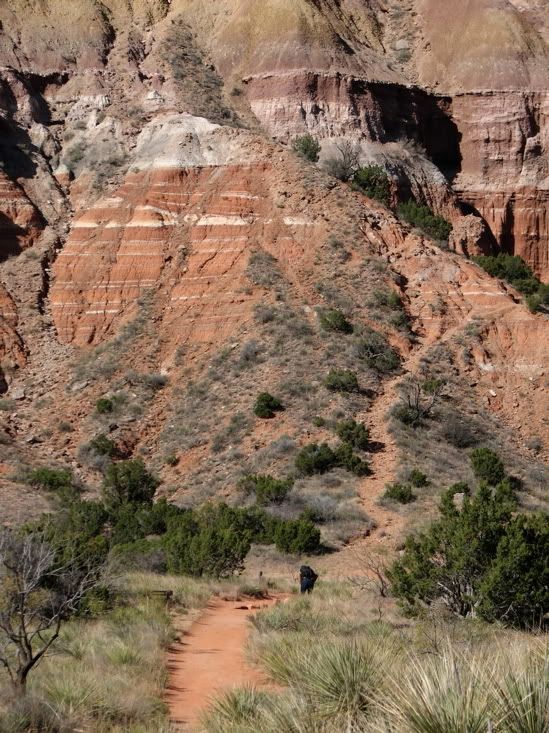
The hoodoo is to the left of the peak.

What is a 'hoodoo'? It is a geological column of rock formed by weathering and erosion. First, a brief introduction to the geology of the canyon.
The Palo Duro Canyon, the second largest in the US, is roughly 800 feet deep. Although the canyon was formed less than a million years ago, its geological history spans 250 million years.
The mural inside the visitor’s center aptly depicts this:
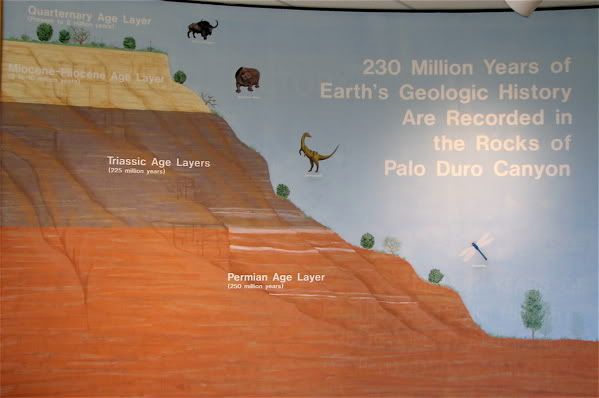
Four formations are prominent throughout the canyon. Fortress Cliff exemplifies them well.
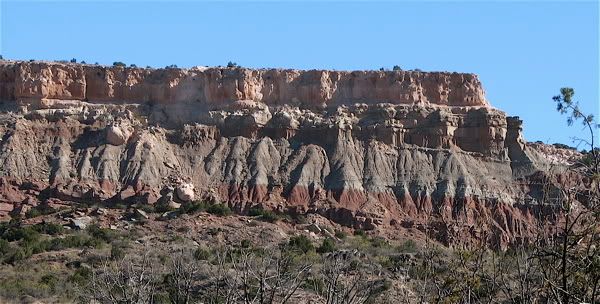
Quartermaster Formation: This is the oldest layer and located at the bottom of the canyon. It is bright red shale and sandstone with layers and veins of white gypsum.
A close-up of this:
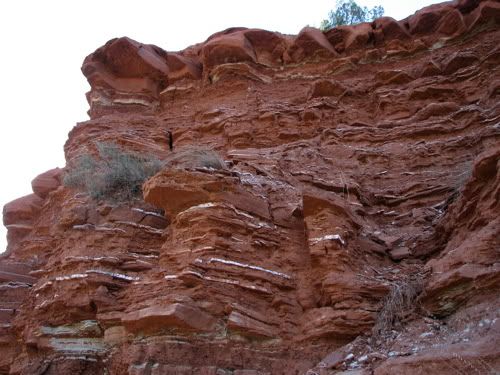
Tecovas Formation: The next layer from the bottom; yellow, gray and lavendar shale, which is compacted clay.
Trujillo Formation: Above the Tecovas is red hard sandstone separated by red clay and course gray gravel.
Ogallala Formation: The top layer is comprised of sand, silt, clay and limestone. This is the caprock of the High Plains.
The Quartermaster and Tecovas layers are well exposed on Captital Peak but the overlying Trujillo and Ogallala layers have been eroded away. The sandstone beds of the Quartermaster layer are more resistant to erosion and protect the shale layers below.
An example of these two layers near Capital Peak:
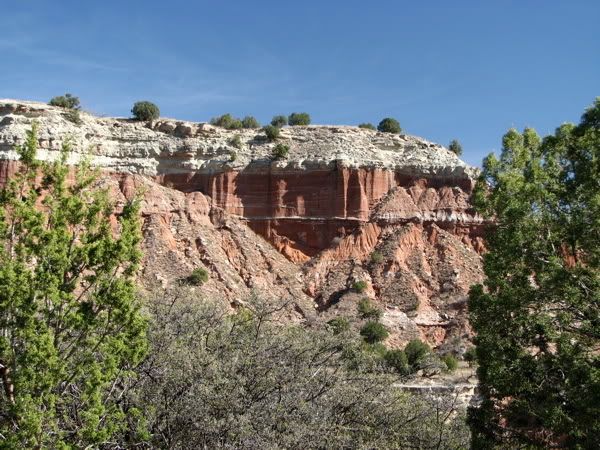
Erosion of shale below the sandstone results in steep slopes, stacks and pedestals called hoodoos. The Lighthouse, a 310-ft hoodoo, is designated a National Natural Landmark.
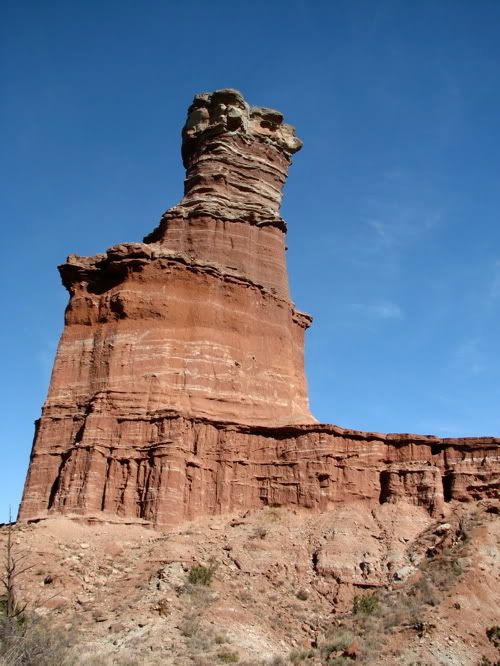
But there were many other examples of hoodoos in all sizes and shapes nearby. In this respect, they reminded one of the geological features seen in Arches and Canyonlands Parks around Moab, Utah.
I hiked over to this area where hoodoo ‘babies’ were aplenty and dwarfed by the nearby Lighthouse which towered over them.

A grouping of them reminded me of a Druid Circle with their canted tabletops.
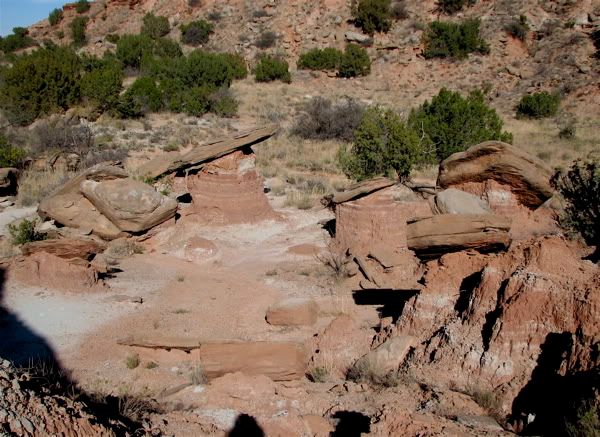
I met a few people on the trail:
A couple requested I take their picture, which I happily obliged. When I mentioned the Lighthouse resembles the Needles in Moab, the woman instantly exclaimed with exuberance that she had lived there for many years. In fact, she has written a few mystery novels that take place in the Moab and canyon area. We chatted excitedly about Moab and the canyons during which Anita commented that the area at the base of the Lighthouse is like a “Little Moab”. I laughed and liked that image, so more than one person thus names it so.
I also met a painter who sat most of the day on the edge of a cliff painting. She was dwarfed and almost camouflaged against the backdrop of the canyons.
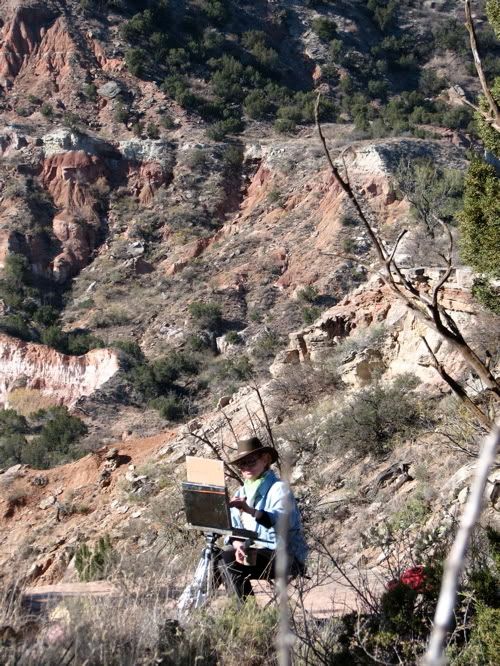
The end of the Lighthouse trail was very steep with some erosion evident that made footing sometimes treacherous.
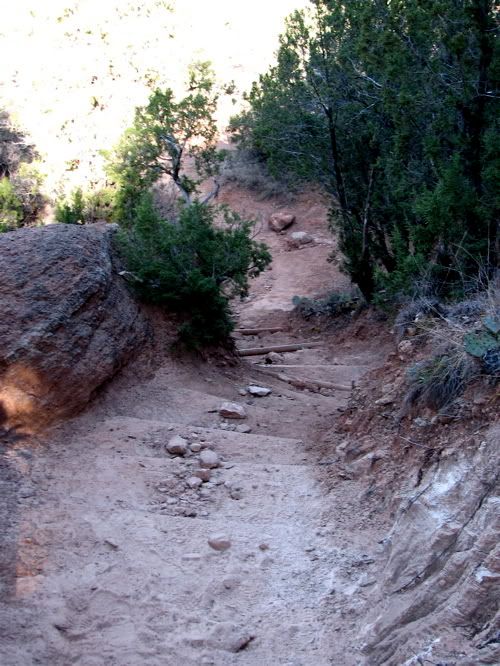
The vistas on the descent were breathtaking.

And the views on the hike back were captivating:
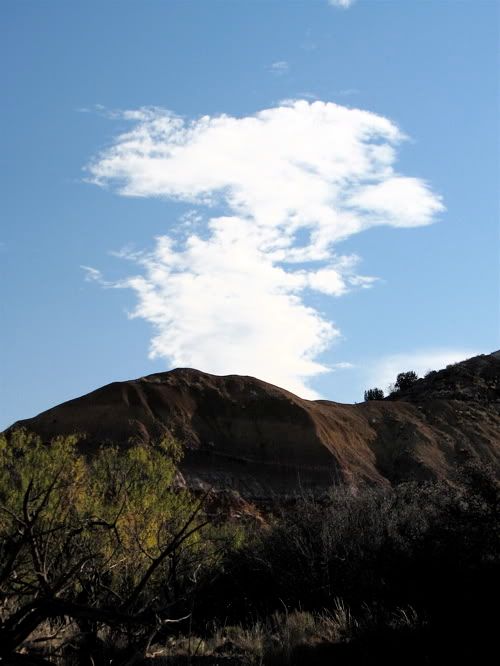

By the time I reached the lower elevations, the sun was in the opposite direction of the sky and the shadows played with everything around me.
No matter where I go, I always have my eternal companion: my Shadow.

The trail to the hoodoo known as the 'Lighthouse' meandered around the base of Capital Peak. The hiker in the photo below may offer a prespective of the scale of these cliffs:

The hoodoo is to the left of the peak.

What is a 'hoodoo'? It is a geological column of rock formed by weathering and erosion. First, a brief introduction to the geology of the canyon.
The Palo Duro Canyon, the second largest in the US, is roughly 800 feet deep. Although the canyon was formed less than a million years ago, its geological history spans 250 million years.
The mural inside the visitor’s center aptly depicts this:

Four formations are prominent throughout the canyon. Fortress Cliff exemplifies them well.

Quartermaster Formation: This is the oldest layer and located at the bottom of the canyon. It is bright red shale and sandstone with layers and veins of white gypsum.
A close-up of this:

Tecovas Formation: The next layer from the bottom; yellow, gray and lavendar shale, which is compacted clay.
Trujillo Formation: Above the Tecovas is red hard sandstone separated by red clay and course gray gravel.
Ogallala Formation: The top layer is comprised of sand, silt, clay and limestone. This is the caprock of the High Plains.
The Quartermaster and Tecovas layers are well exposed on Captital Peak but the overlying Trujillo and Ogallala layers have been eroded away. The sandstone beds of the Quartermaster layer are more resistant to erosion and protect the shale layers below.
An example of these two layers near Capital Peak:

Erosion of shale below the sandstone results in steep slopes, stacks and pedestals called hoodoos. The Lighthouse, a 310-ft hoodoo, is designated a National Natural Landmark.

But there were many other examples of hoodoos in all sizes and shapes nearby. In this respect, they reminded one of the geological features seen in Arches and Canyonlands Parks around Moab, Utah.
I hiked over to this area where hoodoo ‘babies’ were aplenty and dwarfed by the nearby Lighthouse which towered over them.

A grouping of them reminded me of a Druid Circle with their canted tabletops.

I met a few people on the trail:
A couple requested I take their picture, which I happily obliged. When I mentioned the Lighthouse resembles the Needles in Moab, the woman instantly exclaimed with exuberance that she had lived there for many years. In fact, she has written a few mystery novels that take place in the Moab and canyon area. We chatted excitedly about Moab and the canyons during which Anita commented that the area at the base of the Lighthouse is like a “Little Moab”. I laughed and liked that image, so more than one person thus names it so.
I also met a painter who sat most of the day on the edge of a cliff painting. She was dwarfed and almost camouflaged against the backdrop of the canyons.

The end of the Lighthouse trail was very steep with some erosion evident that made footing sometimes treacherous.

The vistas on the descent were breathtaking.

And the views on the hike back were captivating:


By the time I reached the lower elevations, the sun was in the opposite direction of the sky and the shadows played with everything around me.
No matter where I go, I always have my eternal companion: my Shadow.

Labels: Adventures

